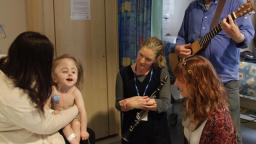
Lydia is five years old and has a rare brain disorder that means she can’t walk or talk. She’s had to spend a lot of her life so far in hospital. The Songbirds project, run by LIME Music for Health, has helped Lydia learn to communicate with her family through music.
Lydia is coming out of her 48th operation at Royal Manchester Children’s Hospital. A nurse warns mum Ruth and dad Paul their daughter is “grumpy” after anaesthetic. But then Ros and Mark arrive – “they always seem to come at the right time,” says Ruth.
Ros and Mark are lead musicians at Songbirds. They’ve been working with Lydia since she was three months old.
Listen to the Songbirds ‘theme tune’, which announces Ros and Mark’s presence on the ward:
Musical beginnings
Lydia’s diagnosis was hard for Ruth and Paul, especially as they lost a daughter Naomi, who had the same genetic condition, at 18 months. But Songbirds has made a big difference to life in hospital for the family.
Lydia responded positively from the very first time she met Ros and Mark. “Lydia loved their music,” Ruth recalls. “When she likes something, she makes an ‘ohhhhhhhhhhh’ sound like James Brown.”
Music-making has benefited Lydia’s parents, brothers and sister too: “It helps us connect with Lydia. The whole family have joined in music-making with Mark and Ros, and I know they have had a big impact on other families too.”
A better quality of life through music
Lots of the children Ros and Mark work with are long-term hospital patients. Many, like Lydia, can’t talk or can only communicate by moving their eyes or fingertips.
Songbirds gives these children confidence that they can communicate without words, and it’s also been shown to help children relax and ease their pain.
“The hospital environment is very noisy,” says Ros. “Children who can’t see or hear well have no idea where this sound is coming from. Music can be there to say ‘It’s okay’.”
Future hopes
Ros and Mark aim to expand Songbirds to support children at home too, while a wider programme trains nurses to understand and communicate with young people through music.
“Lydia loves life and music is a big part of that,” says Ruth. “I don’t know how long we’ve got her for but at least when her time comes, we can say we gave her the best possible life.”
___
Case study researched and written by Trina Wallace: trinawallace.com
